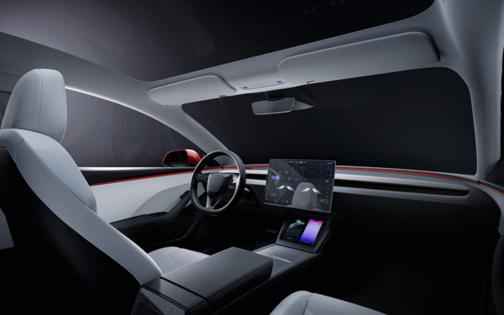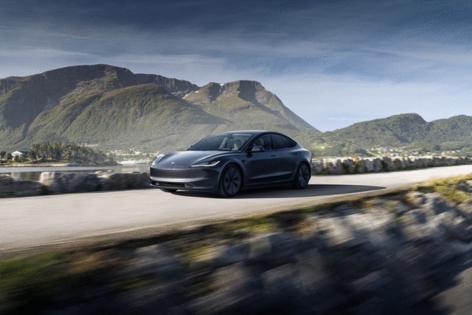Auto review: Behind the (stalkless) wheel of the redesigned Tesla Model 3
Published in Automotive News
TROY, Michigan — The 2024 Tesla Model 3 is the sedan’s first major update and you have questions.
Did it get Apple CarPlay and Android Auto? Nope.
Sirius XM? Nope.
AM radio? Nope.
A head-up display? Nah.
More rear legroom? Nada.
A glovebox button? Negative.
Plastic surgery so its Lord Voldemort face doesn’t keep you up at night? Yup.
A quieter cabin? You bet.
The latter two answers will be welcomed by the Teslerati, and were pleasing upgrades for this (two-time) Model 3 owner. How time flies. It’s been six years since the Model 3 hit the market after a chaotic manufacturing process to meet off-the-chart demand. Codenamed Highland, the ‘24 Model 3 is Tesla’s first chance to tidy up some details.
The quieter cabin was immediately apparent as I zipped out of Troy’s Somerset Collection for a test drive. Tesla says noise, vibration and harshness — NVH — have improved by 20%. Credit upgrades like laminated glass on all windows, improved door-sill sealing, suspension tweaks and upgraded Michelin E-Primacy tires.
The streamlined face is pleasing, even as it erases signature features like the heavy-eyebrow LED running lights. Everything but the doors and quarter panels are new (even aero wheel covers), adding up to aerodynamic efficiencies that help increase range to 341 miles — but you might not notice if you were just strolling by. Tesla makes smartphones on wheels, and is more focused on software upgrades than physical appearance (I honestly can’t remember the design differences between my last two Android smartphones).
Since its debut, Model 3 has marched to the beat of its own drummer. This is a car obsessed with simplification. Heck, Tesla even wants to get rid of you on its path to full self-driving.
So instead of answering basic questions (no AM radio? Really?) Model 3 asks new ones. Like: who needs steering wheel stalks?
The original Model 3 consolidated functions onto the wheel and 15.4-inch center screen. Shift gears? Use the right-hand shift stalk. Turn signal? Left stalk. Everything else — mirrors, volume, adaptive cruise control — was on the steering wheel or screen.
Now the stalks are gone — following big brother Model S, which ditched stalks in 2021.
I shifted gears in the left screen margin: swipe UP for DRIVE, down for REVERSE, press P for PARK, N for NEUTRAL. Kinda’ like Lincoln dash buttons, and a distraction from the road. So are the turn signals, now accessed via buttons on the left of the steering wheel. Rather than adopt raised buttons like a Chevy or Kia, turn signal buttons are flat, requiring your eyes leave the road to find them. If the screen blacks out and you can’t shift? Tesla added redundant shifter buttons behind the rear-view mirror.
It’s a step back in the name of simplification. Other functions sacrificed to stalk removal are adaptive cruise and Autopilot, which now are in the right-side steering wheel roller. Voice commands and windshield wipers are now … less convenient buttons on the wheel.
Two steps forward, two steps back. But the EV GOAT remains as compelling as ever.
After Elon Musk debuted the Model 3 in Los Angeles in February 2016, a flood of 250,000 pre-orders followed from buyers who laid down $1,000 — including this curious auto reviewer.
That demand brought production pressures that nearly crushed the young company. Musk called the next two years “production hell.” The company put up a tent in its Fremont, California, factory parking lot to meet demand. Thousands of 3s had to be repaired due to paint shop glitches. Vehicles suffered gaffes like panel gaps the size of the Rio Grande, bumpers that fell off, and screens that went black.
And yet.
The car was futuristic. Unlike anything we’d seen. Blistering acceleration, constant over-the-air updates like Navigate on Autopilot, bespoke charging network, online, no-haggle ordering. Buyers not only coveted the 3, its popularity spawned an even more popular Model Y SUV version. The 3 is the best-selling luxury car in the market, and the 12 th best-selling vehicle in America.
Assuming you could put up with that Voldemort mug. I ordered my cars in black to diminish the nose.
Merging onto Big Beaver, I stomped the throttle and the entry-level 3,891-pound, rear-wheel-drive model darted forward. Ahhh, sweet electric torque.
It was noticeably livelier than the porky 5,200-pound Chevy Blazer EV I recently drove. In addition to the quieter cabin, the suspension upgrades make Model 3 feel tighter next to my 2019 Performance model. The all-wheel-drive Performance version of the Highland will arrive later — when it does, I’ll take it on track to see if the tighter steering translates to better corner-carving.
I’m a fan of the 3’s iPhone-simple horizontal interior anchored by a jumbotron screen. The ‘24 Highland brings upscale updates like a thinner screen bezel, heated/cooled seats and square-bottom steering wheel so I can more easily slide my long legs into the seat. The interior has been reskinned with trendy cloth inserts (replacing last gen’s wood accents) and a more organized center console that includes two standard wireless charging ports. Most noticeable is ambient lighting that circles the cabin and can be adjusted to the color of your choice.
Other hardware updates include crisper cameras, which help for backing into parking spaces (unless you just let the car park for you), and 17 speakers for better sound quality.
The user interface is the same, and I navigated the screen and its familiar controls.
At a Michigan turn on Big Beaver, I reached for the turn stalk, grabbing at thin air. Oh, yes — where are those turn signal buttons? Actuating adaptive cruise control was easier, as I punched the right scroll wheel with my thumb.
Blind-spot assist comes via a camera image in the screen (putting blind-spot lights in the mirrors would violate the simplification theme), just like the last gen.
Back-seat occupants may not gain legroom — but they do get their own 8-inch screen, which includes temperature controls, heated seat controls, access to Netflix shows and a valet mode so you can move the front passenger seat forward. It’s a small but mighty screen.
All that standard equipment makes the Tesla a deal at $40,380. While the Model 3 still hasn’t hit its promised $35,000 mark from 2017, it’s satisfying to get this wealth of goo-gaws without being nickel-and-dimed like other luxury brands.
Save for Full Self-Driving capability, which will set you back, ahem, $12,000.
2024 Tesla Model 3 Highland
Vehicle type: Electric, rear- and-all-wheel-drive, five-passenger luxury sedan
Price: $40,380, including $1,390 destination charge (as tested)
Powerplant: 80.5-kWh lithium-ion battery with electric motor(s) drive
Transmission: Single-speed transmission
Weight: 3,891 pounds (RWD, as tested); 4,030 pounds for long-range battery, AWD model
Power: NA
Performance: 0-60 mph, 5.8 seconds, RWD as tested (mfr.); 4.2 seconds (AWD)
Fuel economy: EPA est. range, 272–341 miles
Report card
Highs: More attractive, simplified fascias; quieter cabin
Lows: Distracting screen button shifter; no AM radio, Apple CarPlay, Android Auto
Overall: 4 stars
____
©2024 www.detroitnews.com. Visit at detroitnews.com. Distributed by Tribune Content Agency, LLC.










Comments